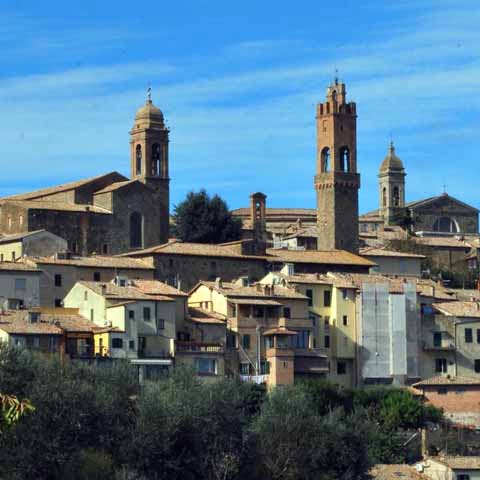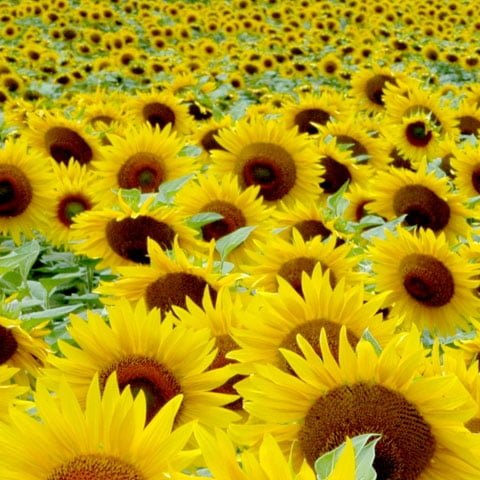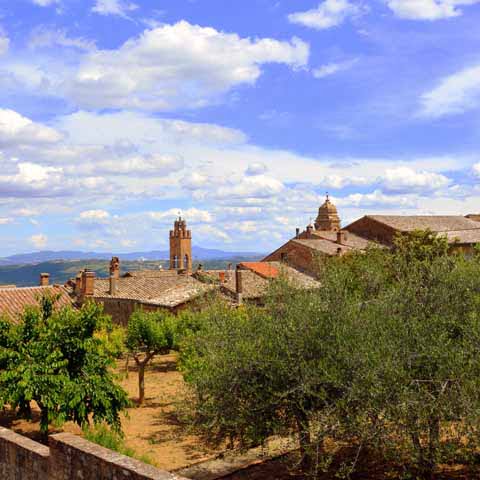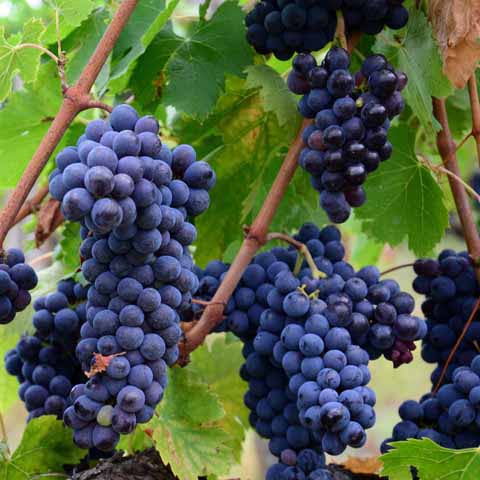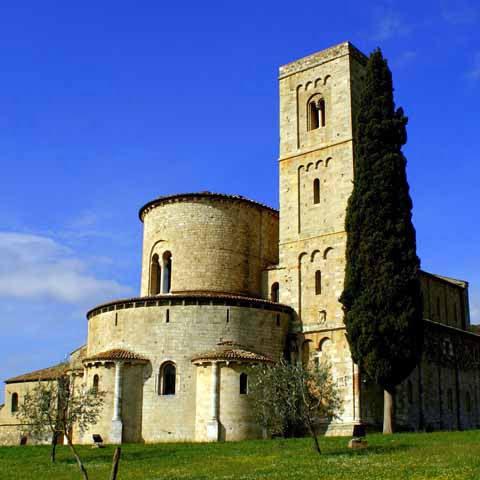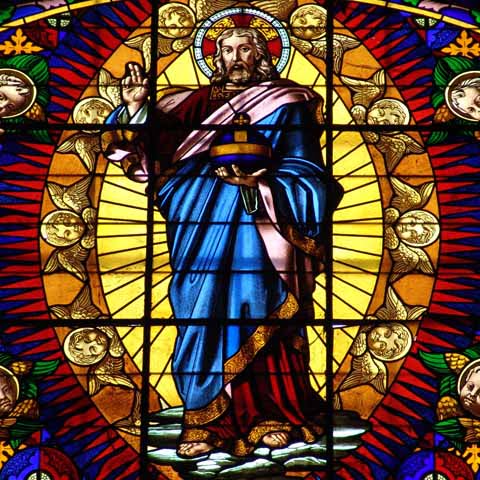The village of Montalcino is a town situated about 1,860 feet above sea level in the province of Siena, which is part of the Tuscany region of Italy and is rooted in the heart of wine country. The town derives from notable Etruscan-Roman beginnings and has an ancient heritage. Historically, it was an important location along the road to Rome and presents a sweeping perspective of the Asso, Orcia, and Ombrone Valleys. Along with the hamlets of Castelnuovo dell’Abate, Camigliano, Montisi, Sant’Angelo in Colle, San Giovanni d’Asso, and Torrenieri, Montalcino is a beautifully modest town with a storybook look where the sightseer feels like he or she stepped into the pages of a fairy tale. The small city is surrounded by a fourteenth-century fortress complete with thick stone walls and numerous turrets.
The very first settlement of Montalcino, (earliest records indicate 814 AD), was influenced by feudal monks. They expanded the site into a municipality of substantial importance, both from a political and military standpoint. As a result of its strategic positioning on the Francigena Way, the town clashed with Siena starting at the end of the twelfth century and continued to do so for approximately seven decades. During this period, war alternated with times of precarious peace. Though autonomous for a period in the twelfth century, the town fell under Sienese rule. Throughout the fourteenth century, the city’s fortress was engaged to safeguard the southernmost boundary of the Sienese Republic.
The Palazzo dei Priori, the focal point of the city that today functions as the town hall, is an attractive loggia with Gothic arches in stone. The nearby Civic Diocesan Museum houses remarkable works of Sienese art. From the fortress ramparts, you can observe the Val d’Orcia Natural Park, as well as the ambling sun-drenched hills that are blanketed with flowers, old oaks, and beautiful olive groves. Picturesque avenues wind through fabulous vineyards sloping gently away from the elevated city. In medieval times, the village was recognized for its tanneries and for the goods crafted from the premium quality leathers that were made there.
Nowadays, Montalcino is renowned for its wines, especially the Brunello di Montalcino. Besides delightful wines, the region also yields high-quality extra virgin olive oil, savory meats, cheeses, and honey, all of which may be experienced in one of the local bistros or wine bars.
GEOGRAPHY & CLIMATE
Nature lovers are in for a treat and will enjoy visiting the lovely countryside that surrounds Montalcino. The terrain here is characterized by lush forests scattered with olive trees and grapevines. These kinds of stunning vistas have made the landscape of Val d’Orcia a UNESCO World Heritage Site.
Montalcino is among the warmest and driest environments in Tuscany. Monte Amiata, the tallest mountain in Southern Tuscany, offers a sheltering effect from the southeast, mitigating the region’s temperatures and rain conditions. The climate is warm and mild in Montalcino. The winters are rainier compared to the summer months. The driest month is July, and the wettest month is in November. The climate is such that virtually any time of year proves an excellent opportunity to visit this treasure trove of Italian delights.
WHEN IN MONTALCINO
Like most if not all of Italy, and Tuscany in particular, there is much history, art, architecture, food, wine, festive events, and beautiful countryside to take in and savor in Montalcino. Art and history enthusiasts can discover treasures at the Diocesan Museum of Sacred Art, which houses one of the most valuable collections of art, sculptures, and frescoes in the area — a visit well worth experiencing.
Among the places of worship in town, the fourteenth-century Church of Sant’Agostino stands out for its sheer architectural beauty and should be high on the list of places to see, along with the Sanctuary of the Madonna del Soccorso, the Church of Sant’Egidio, and the Neoclassical Cathedral of San Salvatore. Though it is not a church, the tall clock tower of the Palazzo dei Priori is a lovely edifice right out of history.
The singular yet striking Abbey of Sant’Antimo, a monumental construction dating back to the twelfth century, is an excellent representation of Romanesque architecture encompassed by serene surroundings. A must-see for visitors who enjoy ancient architecture with a rich history, the abbey is situated a few miles outside of Montalcino.
The Museo del Vetro or Glass Museum tells the history of glass making. The museum, residing in the splendid Castle of Poggio alle Mura, showcases a fascinating assortment of glass and tools from Egyptian to Roman to the Venetian times.
Wine aficionados will appreciate the local Montalcino vintages. Brunello di Montalcino is among Italy’s most well recognized and esteemed Tuscan wines. In international marketplaces, it receives much interest. The wine is deep red in coloring with fragrances of fruit and underlying spice. Brunello di Montalcino wines are created solely from Sangiovese Grosso grapes cultivated on the slopes around Montalcino, south of Siena. Those with a discerning palate will quickly understand the quality of this fine wine.
The small streets that are paved with natural stone make for pleasant and enchanting strolls. The streets are lined with shops, storefronts, and bistros where you can purchase local wines, delicious food, and more. The Fortezza is the location for a sizable food festival that takes place in October and offers delicacies such as polenta, roasted thrushes, and Brunello wine.
Visitors will delight in many events, including concerts, wine tastings, and shows. The celebrated Jazz & Wine Festival is a jazz concert series held in the fortress that enlivens summer evenings and features famous musicians from all over the world. The festival customarily takes place in July.
An easy stop from anywhere in Tuscany, experience Montalcino for something a little different and unique. The town has not been affected by the passage of time and still retains the old-world charm of the sixteenth century. The churches, cobbled lanes, fort, clock tower, and municipal palace harken back to a distant and fascinating era. Montalcino, located in the heart of the Val d’Orcia area, is well-worth a modern-day trip back in time.
Travel Guides
The Tuscany Region of Italy
The Cities of Tuscany, Italy
